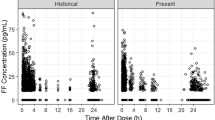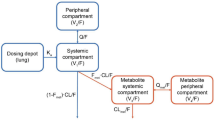Summary
The predictability and intraindividual variability of serum theophylline concentrations (STC) after different dosing schedules were investigated in 24 patients with chronic obstructive lung disease (COLD). Three oral regimens were compared in 3 groups of 8 randomly assigned patients. Group I: Drug A once daily in the evening; Group II: Drug A b.d.; Group III: Drug B b.d. The doses for each patient were estimated by Bayesian forecasting aiming at an STC of 10–15 mg/l. STC and FEV1 were measured on two consecutive days at steady-state. The day-to-day variability of STC was less than 20% in all three groups. The within-day fluctuation in Group I amounted to 259% (median) compared to 57% and 38% in Groups II and III, respectively. Dose adjustment by Bayesian forecasting resulted in a therapeutic STC in most patients with a b.d. regimen, whereas for the once daily dose the prediction was not satisfactory. No difference in lung function was found between the 24-h and 12-h dosing, probably because of the large intersubject variability in FEV1. Therefore, the question whether the differences in STC profile are of clinical importance in COLD can only be investigated in a larger group of patients.
Similar content being viewed by others
References
Barnes PJ, Greening AP, Neville L, Timmers J, Poole GW (1982) Single-dose slow-release aminophylline at night prevents nocturnal asthma. Lancet I: 299–301
Box GEP, Hunter W, Hunter JS (1978) Statistics for experiments. An introduction to design data analysis and model building. Wiley, New York, pp 571–573
Cole RB, Al-Khader A (1979) Effect of slow-release oral aminophylline on circadian variation in airflow obstruction in asthmatics. J Int Med Res 7 [Suppl I]: 40–44
Connolly CK (1979) Diurnal rhythms in airway obstruction. Br J Dis Chest 73: 357–367
Fanta CH, McFadden ER (1985) Pharmacokinetics and clinical response to single- and multiple-dose sustained-release theophylline compounds in perennial bronchial asthma. Am J Med 79 [Suppl 6A]: 54–57
Fairshter RD, Bhola R, Thomas R, Wilson AF, Hyatt J, Snapp S, Cummins L (1985) Comparison of clinical effects and pharmacokinetics of once-daily uniphyl and twice-daily Theo-Dur in asthmatic patients. Am J Med 79 [Suppl 6A]: 48–53
Hetzel MR (1981) The pulmonary clock. Thorax 36: 481–486
Jonkman JHG, van der Boon WJV, Balant LP, Schoenmaker R, Holtkamp A (1983) Chronopharmacokinetics of theophylline after sustained-release and intravenous administration to adults. Eur J Clin Pharmacol 26: 215–222
Lesko LJ, Brousseau D, Canada AT, Eastwood G (1980) Temporal variations in trough serum theophylline concentrations at steadystate. J Pharm Sci 69: 358–359
Levene S, McKenzie S (1986) Once daily theophylline in childhood asthma. Br J Dis Chest 80: 66–71
Peck CC, Brown WD, Sheiner LB, Schuster BG (1980) A microcomputer drug (theophylline) dosing program which assists and teaches physicians. In: O'Neil JT (ed) Proceedings of the 4th Annual Conference on Computers in Medical Care. Institute of Electrical and Electronic Engineers, New York, pp 988–994
Pedersen S (1985) Treatment of nocturnal asthma in children with a single dose of sustained-release theophylline taken after supper. Clin Allergy 15: 79–85
Powell JR, Vozeh S, Hopewell P, Costello J, Sheiner LB, Riegelman S (1979) Theophylline disposition in acutely ill hospitalized patients. Am Rev Resp Dis 118: 229–238
Sheiner LB, Beal SB (1981) Some suggestions for measuring predictive performance. J Pharmacokinet Biopharm 9: 503–512
Sheiner LB, Beal SB (1982) Bayesian individualization of pharmacokinetics: simple implementation and comparison with non-Bayesian methods. J Pharm Sci 71: 1344–1348
Sheiner LB, Beal SB, Rosenberg B, Marathe VV (1979) Forecasting individual pharmacokinetics. Clin Pharmacol Ther 26: 294–305
Sheiner LB, Rosenberg B, Melmon KL (1972) Modelling of individual pharmacokinetics for computer-aided drug dosage. Comp Biomed Res 5: 441–459
Taylor DR, Duffin D, Kinney CD, McDevitt DG (1983) Investigation of diurnal changes in the disposition of theophylline. Br J Clin Pharmacol 16: 413–416
Uematsu T, Follath F, Vozeh S (1986) Circadian changes in the absorption and elimination of theophylline in patients with bronchial obstruction. Eur J Clin Pharmacol 30: 309–312
Turner-Warwick M (1977) On observing patterns of airflow obstruction in chronic asthma. Br J Dis Chest 71: 73–86
Vozeh S, Muir KT, Follath F, Sheiner LB (1981) Predicting individual phenytoin doasge. J Pharmacokinet Biopharm 9: 131–145
Welsh PW, Reed CE, Conrad E (1986) Timing of once-a-day theophylline dose to match peak blood level with diurnal variation in severity of asthma. Am J Med 80: 1098–1102
Author information
Authors and Affiliations
Rights and permissions
About this article
Cite this article
Schmidlin, O., Vozeh, S., Keller, B. et al. Predictability and intraindividual variability of serum theophylline concentrations in patients with obstructive lung disease: 12-h versus 24-h dosing. Eur J Clin Pharmacol 39, 253–256 (1990). https://doi.org/10.1007/BF00315105
Received:
Accepted:
Issue Date:
DOI: https://doi.org/10.1007/BF00315105




